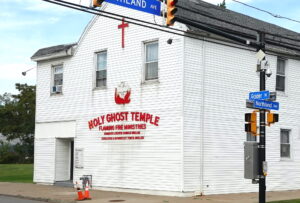We continue the series on walking Buffalo, from the intrepid couple who walked every day—no matter the weather—in the first 30 months of Covid. They think (without being systematic) they walked every street in Buffalo, and many in other cities and towns, taking some 20,000 photos, some of which are shared in this series. While not itineraries, we hope to encourage others to “walk the walk,” to see, observe and appreciate Buffalo—and beyond. William Graebner and Dianne Bennett are also 5 Cent Cine’s film critics, here.
Today’s Photo-Essay: Those Long Buildings, on the Corner
I remember well the moment when I “saw” my first “long” Buffalo building, when I became conscious of the form that I had seen, and photographed, before. We were returning from a Covid vaccination, thanks to the agreeable Rite Aid on Connecticut Street. And there it was, in the twilight, that magnificent—it seemed monumental—building on the corner of 16th Street.
That special moment was not to be repeated, but it did come to represent our growing awareness that there were a lot of very, very long buildings, most—but not all—on the corners of Buffalo’s streets and avenues. Here we offer just a few.
Buffalo’s “long” buildings are often located on side streets, in neighborhoods. The two below are In the Old First Ward. We were walking the area when we encountered a 70-year-old Irishman, who had owned and managed the white building at Mackinaw and Vincennes for forty years. Four apartments, he told us. Across the street was its mate—now “mostly storage,” he said. He suggested the large buildings were for the large families of the Irish and Italians.
We seldom have that first-hand information. So we’ve often wondered what those long buildings “were”—what they were built to be, and what they became (and what they are now). Apartments? A boarding house? A bar? The site of a failed business? To walk is to wonder, to imagine, to guess.
This monster, at West and Rhode Island, has been so defaced by first-floor remodeling that its original purpose is obscure, though it seems clear that the first floor once housed a business. Two fire escapes, each serving at least two apartments, suggest that the second floor contains multiple residences.
In calculating how many apartments a “long house” contains, it can help to count the gas or electrical meters that service the structure. It’s likely that this Lackawanna beast has 5 apartments. The front windows suggest it may once have housed a business, though perhaps not a bar—there is (not now, anyway, no side entrance). It was for sale—in 2021.
This Riverside property was likely always an apartment house. The 4 gas meters (in front) and the 4 electric meters (on the side) suggest 4 apartments.
In contrast, this red-brick West-Side conglomeration was probably assembled over time. The original front section may date to the 1870s.
The well-maintained beauty at 16th and York once had a store in front. Our guess is that the rear section was a late addition. No less elegant is a long building on the East Side (Cold Spring/Masten) which finishes with a barn-like garage, an indication that it dates to the horse-drawn era.
It’s safe to say that long buildings on the corners of major commercial thoroughfares were designed to house businesses, often with a 2nd-floor owner’s apartment. A Riverside building on Niagara Street, now being refurbished, features an elegant cupola. At 1265 Broadway on the East Side, just off the corner at Young Street, sits another building that always had a storefront. Related to the “telescope” structure popular on the East Side, it has at least two additions to the original unit—right back to the property line.
If it has a corner entrance (and a side entrance), it’s likely to have been a bar. Case in point: 424 17th Street, on the West Side. It still has the single, supporting pole at the entrance. Apartments in back. The Twilight Grill is at Thomas and Howard on the East Side, not far from the Central Terminal (when we visit the grounds of the Terminal, we park on Thomas Street). The glass block that runs the length of the building usually means “bar.”
Who knows what was once housed in this long building at Grider and Northland, now the Holy Ghost Temple/Flaming Fire Ministries?
Broadway area. Not on a corner, but wonderfully long. The doors at right look very old. Otherwise a mystery.
How to Take a Walk—in Buffalo – (Alternative) Places to Hang
How to Take a Walk in Buffalo – Look Up! Roofs and Roofers
How to Take a Walk in Buffalo – Buffalo’s Mini-Marts
How to Take a Walk in Buffalo – Remembering 9/11
How to Take a Walk in Buffalo – Street Humor
How to Take a Walk in Buffalo – The Yard as Spectacle
How to Take a Walk in Buffalo – Beware of (the) Dog
How to Take a Walk in Buffalo — Halloween
How to Take a Walk in Buffalo: Little-Known Trails and Paths
How to Take a Walk in Buffalo: Church Board Advice
How to Take a Walk—in Buffalo: Coping with Covid
How to Take a Walk—in Buffalo: Planters
How to Take a Walk—in Buffalo: Christmas Tidings
How to Take a Walk—in Buffalo: Murals… Off-the-Beaten Path
How to Take a Walk—in Buffalo: Scajaquada Creek
How to Take a Walk in Buffalo – Block Clubs
How to Take a Walk—in Buffalo – Black Lives Matter
How to Take a Walk—in Buffalo: Once a Bar
How to Take a Walk—in Buffalo: Queen City Sculpture
How to Take a Walk—in Buffalo: Flying the Flag – Education 101
© William Graebner
The post How to Take a Walk—in Buffalo, and Beyond: <strong>Those Long Buildings, on the Corner</strong> appeared first on Buffalo Rising.

